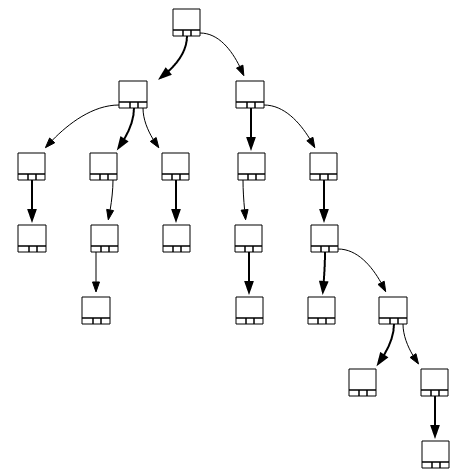8 releases
Uses old Rust 2015
| 0.1.1 | Jan 13, 2020 |
|---|---|
| 0.1.0 | Nov 9, 2019 |
| 0.0.6 | Feb 23, 2019 |
| 0.0.1 | Jan 21, 2019 |
#1855 in Data structures
30 downloads per month
Used in ternary-tree-wasm
75KB
1K
SLoC
ternary-tree
A Rust implementation of Ternary Search Trees, with no unsafe block and a simplified Wasm binding.
A Ternary Search Tree (TST) is a data structure which stores key/value pairs in a tree. The key is a string, and its characters are placed in the tree nodes. Each node may have three children (hence the name): a left child, a middle child and a right child.
A search in a TST compares the current character in the key with the character of the current node:
- If both matches, the search traverses the middle child, and proceed to the next character in the key
- If the key character is less than the node one, the search simply goes through the left child, and keep looking for the same key character
- Respectively, if the key character is greater than the node one, the search simply goes through the right child
The data structure and its algorithm are explained very well in Dr.Dobb's Ternary Search Trees article.
The following tree is the TST we get after inserting the following keys in order: "aba", "ab", "bc", "ac", "abc",
"a", "b", "aca", "caa", "cbc", "bac", "c", "cca", "aab", "abb", "aa" (see tst.dot produced by code below)
A checked box "☑" denotes a node which stores a value (it corresponds to the last character of a key). An empty box "☐" means that the node has no value.
A TST can be used as a map, but it allows more flexible ways to retrieve values associated with keys. This crate provides four ways to iterate over the values of a TST:
- get all values (same as a regular map), with
visit_valuesoriter - get all values whose keys begin with some prefix (i.e. complete some prefix), with
visit_complete_valuesoriter_complete - get all values whose keys are close to some string (Hamming distance), with
visit_neighbor_valuesoriter_neighbor - get all values whose keys match a string with some joker (e.g. "a?c"), with
visit_crossword_valuesoriter_crossword
Visit methods are recursive and apply a closure to found values. They exist in immutable and mutable version
(i.e. visit_neighbor_values_mut). But once a value is found (based on its key), they offer no way to know what
the actual key is.
Iterators, on the other hand, save their context in a Vec and only work on immutable trees. However they are
double-ended, and support next and next_back methods to walk the tree from both ends. Moreover, once a value is
found, they offer the current_key and current_key_back methods to retrieve the associated key.
The following lines may give you a foretaste of this crate and TSTs
extern crate ternary_tree;
use ternary_tree::Tst;
use std::fs::File;
use std::error::Error;
const SOME_KEYS : [&str; 16] = ["aba", "ab", "bc", "ac",
"abc", "a", "b", "aca", "caa", "cbc", "bac", "c", "cca",
"aab", "abb", "aa"];
let mut map = Tst::new();
for key in &SOME_KEYS {
// Say the value is the same as the key,
// it makes the example easier !
let some_value = *key;
map.insert(key, some_value);
}
// Use Graphviz to convert tst.dot to tst.png:
// dot -T png -o tst.png tst.dot
let mut file = File::create("tst.dot").unwrap();
map.pretty_print(&mut file);
let mut v = Vec::new();
// Recursively get all values whose keys match "a?a" pattern
map.visit_crossword_values("a?a", '?', |s| v.push(s.clone()));
assert_eq!(v, ["aba", "aca"]);
v.clear();
// Iterate over all values whose keys are close to "abc"
// (At a Hamming distance of 1 from "abc")
{
let mut it = map.iter_neighbor("abc", 1);
while let Some(value) = it.next() {
v.push(*value);
}
assert_eq!(v, ["ab", "aba", "abb", "abc", "cbc"]);
v.clear();
}
// Mutate all values whose keys begin with "c"
map.visit_complete_values_mut("c", |s| *s = "xxx");
assert_eq!(map.get("caa"), Some(&"xxx"));
assert_eq!(map.get("cbc"), Some(&"xxx"));
assert_eq!(map.get("cca"), Some(&"xxx"));
License: BSD-3-Clause
